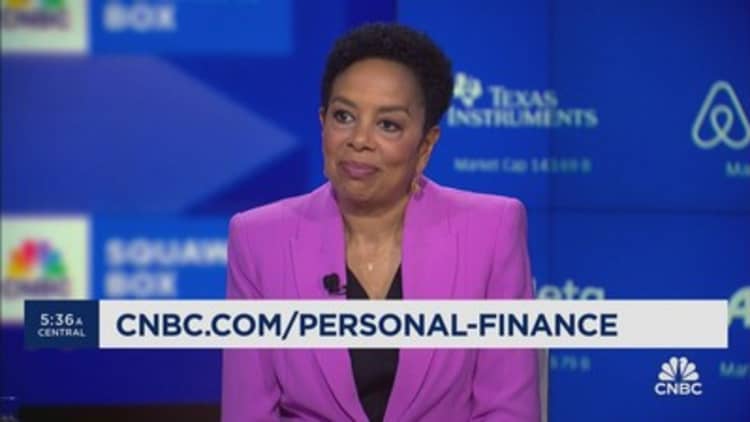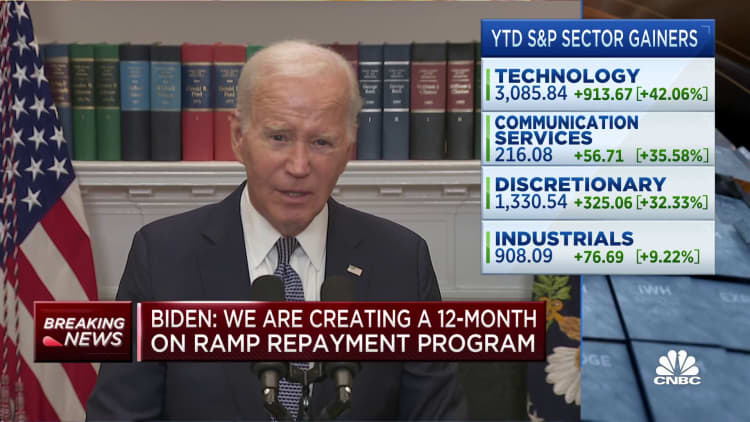The Baltimore bridge collapse could cost up to $4 billion in insured losses, which would make it the most expensive incident involving a ship collision for insurers in modern history.
Personal Finance
Baltimore bridge collapse could yield the largest maritime insurance losses
Published
1 month agoon

“This is the biggest claim that we’ll likely see in marine insurance,” said Brian Schneider, senior director at Fitch Ratings’ North American insurance rating arm, who expects the final total to come in between $2 to $4 billion in insured losses.
That could make it more expensive than the capsizing of the Costa Concordia in 2012, Schneider said. In that case, a multistory cruise liner carrying more than 4,000 passengers and crew ran aground and capsized off Italy’s west coast, killing 32 people, which ended up costing $2 billion — the costliest maritime disaster so far.
The company responsible for paying the insurance losses for the bridge damage and negligence of the Dali is International Group of P&I Clubs, which also has reinsurance that provides marine liability coverage to the Dali. This insurance policy will cover damage to the bridge, as well as wreck removal, loss of life and negligence of the Dali.
Repairing or replacing the bridge will be expensive, as the price of steel has been going up, said David Osler, insurance editor at Lloyd’s List, a shipping news company.
“It will take a heck of a lot of steel to repair that bridge,” Osler said.
The hull damage, pollution and cargo losses were insured separately in the market as property coverage. Generally, most shippers also get a separate insurance product to cover business interruption, which could be add to the losses, given the busy Port of Baltimore. It’s not confirmed at this point if the shippers or the Dali have business interruption insurance.
“The Port of Baltimore is the busiest port for car shipments in the U.S.,” said Schneider of Fitch. “That could impact a lot of business-interruption policies, such that there will be liability for all the shipping that is not taking place now.”
Rating agency Morningstar DBRS said the losses will add to the woes of marine insurers, who have been facing a number of serious challenges in recent years. The pandemic, the war in Ukraine, piracy in the Horn of Africa and Gulf of Yemen, and a string of attacks from Houthi militants in the Red Sea have created a “perfect storm” causing the shipping industry to buy more insurance, experts said.
“The trade interruptions caused by the pandemic have meant that shippers have become more aware of the need to have supply chain insurance, which is a relatively new product,” said Marcos Alvarez, head of insurance at the ratings firm DBRS Morningstar.
The Panama Canal is taking longer to cross because of some drug trade issues, Alvarez said. And the Red Sea piracy issues are diverting 80 percent of traffic south of Africa, adding 10 to 14 days to trips, “meaning more costs, more fuel, more insurance,” Alvarez said.
Apart from the added value of the journeys, some shippers are also adding insurance to protect against a phenomenon known as “social inflation” — in which juries hand out more generous payouts to those who bring claims for negligence and escalating settlement awards, insurance experts say.
The families of the six bridge workers who died in the crash are expected to file a lawsuit over the incident, Alvarez said.
“There will be worker compensation lawsuits, there will be life insurance settlements, and, of course, the boat insurance will be in play,” he said. “And this is happening in one of the most litigious jurisdictions in the world, the U.S.”
One possible reprieve for insurers could come from a little-known maritime law from 1851 called the Limitation of Liability Act, which caps the ship’s liability to the post-accident value of the boat and its cargo. The owners of the Titanic used this law to limit how much they were forced to pay out after the ship sank in 1912. That same law could cap how much insurers have to pay for the damage to the boat itself. However, the liability cap probably won’t hold down insurance payouts for the bridge or the interruption of business for the port or for other shippers, Alvarez said.
You may like
Personal Finance
Here are key things to know about company stock, experts say
Published
2 weeks agoon
May 4, 2024
Prasit photo | Moment | Getty Images
As employers compete to attract and retain talent, equity compensation — or an ownership stake in the company — has become a key workplace benefit.
Some 72% of companies offer some form of equity compensation to certain employees, a 2023 survey from Morgan Stanley found. That’s up from 65% in 2021.
These perks motivate employees and boost their long-term investing goals, according to the Morgan Stanley survey, which polled 1,000 U.S. employees and 600 human resource executives.
However, some “miss the opportunity” because they don’t understand it, said certified financial planner Chelsea Ransom-Cooper, chief financial planning officer for Zenith Wealth Partners in New York.
More from Personal Finance:
This job perk is like a ‘cash bonus’ — but you need a long-term strategy, experts say
Employee stock purchase plans offer ‘free money’ — but also carry complexity and risk
Treasury Department announces new Series I bond rate of 4.28% for the next six months
Here’s what to know about three popular types of stock-based compensation, experts say.
There’s potential for ‘life-changing wealth’
Many employees receive so-called stock options as part of their compensation, which are the right to buy or “exercise” company shares at a preset price within a specific timeframe.
“It’s almost iconic to grant stock options in a startup private company,” said Bruce Brumberg, editor-in-chief and co-founder of myStockOptions.com, which covers various types of equity compensation.
Startups want to create the drive and incentive of ownership culture with the potential for “life-changing wealth,” he said.
Stock options become valuable when there’s a discount between your preset price and the market value, which makes it more attractive to exercise. However, the taxes can be complicated, depending on the type of stock options.
Incentive stock options can offer some tax benefits — if you meet certain rules — but could trigger the alternative minimum tax, a parallel system for higher earners.
Photo by LanaStock via Getty Images
By comparison, the more common nonqualified stock options generally have less favorable tax treatment and you’ll owe regular income taxes on the discount upon exercise.
But even with an initial discount, there’s no guarantee a company’s stock price won’t decrease after exercising a stock option.
“It could be worth nothing but a piece of paper,” Ransom-Cooper from Zenith Wealth Partners said.
Restricted stock units are ‘like a cash bonus’
Another benefit, restricted stock units, or RSUs, are company shares granted upon hiring, which vest over time. RSUs can also be tied to performance-based goals.
Some 94% of public companies offer RSUs to at least middle managers, according to a 2021 survey from the National Association of Stock Plan Professionals.
“I like to think of it like a cash bonus,” said Pittsburgh-based CFP Matthew Garasic, founder of Unrivaled Wealth Management.
I like to think of it like a cash bonus.
Matthew Garasic
Founder of Unrivaled Wealth Management
For example, if the stock price is $10 and 100 shares vest, it’s treated like $1,000 in compensation for that year, and the standard withholding of 22% might not be enough, depending on your tax bracket, he explained.
After vesting, the decision to sell or hold RSUs depends on your short- and long-term investing goals.
“We like to establish a target of what they like to hold in company stock,” said Garasic, who aims to keep allocations of a single stock to 10% or less. “Once we get above that target, we just sell at vest.”
Employee stock purchase plans offer ‘free money’
Many publicly traded companies may also offer discounted company shares via an employee stock purchase plan, or ESPP.
“There’s free money to be had” with an ESPP, Garasic explained.
However, the decision to participate typically depends on your short-term financial goals.
After enrolling, your ESPP collects a portion of after-tax money from each paycheck and uses the funds to buy discounted company stock on a specific date.
The gold standard is a 15% discount with a lookback feature, which bases the stock purchase price on the value at the beginning or end of the offering period, whichever is lower, experts say.
Any time you’re investing in a single company, there’s certainly a big risk.
Kristin McKenna
President of Darrow Wealth Management
You can typically sell after a set period, but there’s no guarantee you’ll make money, even with the built-in discount.
“Any time you’re investing in a single company, there’s certainly a big risk,” CFP Kristin McKenna, president of Darrow Wealth Management in Boston, previously told CNBC.
Yearly goals like investing up to your employer’s 401(k) match should come before your ESPP, especially with limited income, she added.

Personal Finance
Public Service Loan Forgiveness program will go on partial pause
Published
2 weeks agoon
May 3, 2024
Teacher teaching her students in art class at school.
Fg Trade | E+ | Getty Images
The popular Public Service Loan Forgiveness program began a partial processing pause on May 1, which will likely run through July, the U.S. Department of Education recently said.
The temporary suspension comes as the Biden administration overhauls the once-troubled federal student loan program.
Here’s what borrowers should know.
Why the pause is happening
The PSLF program, signed into law by President George W. Bush in 2007, allows certain not-for-profit and government employees to have their federal student loans canceled after 10 years of on-time payments.
However, the program has been plagued by problems, making people who actually get the relief a rarity.
Borrowers often believe they’re paying their way to loan cancellation only to discover at some point in the process that they don’t qualify, usually for confusing technical reasons. Lenders have been blamed for misleading borrowers and botching their timelines.
More from Personal Finance:
Advice about 401(k) rollovers is poised for a big change. Here’s why
IRS free filing pilot processed more than 140,000 returns, commissioner says
Here’s why new home sales inch higher despite 7% mortgage rates
The Biden administration has been trying to reform the program. As part of that overhaul, it is changing how loan servicing works for public servants, and some of the customer service will soon be handled by the government itself.
“After the improvements, PSLF borrowers will have all of their PSLF information centralized on StudentAid.gov so that the Department can provide real-time and more accurate information on payment counts and form processing,” the Education Department wrote in a recent blog post.
Previously, only one company managed the servicing for PSLF borrowers on behalf of the government: first, FedLoan, and more recently, Mohela, or the Missouri Higher Education Loan Authority. Going forward, a number of different companies will service the accounts, along with the Education Department.
What borrowers can expect during the transition
The Education Department will not review PSLF form submissions for roughly a two-month period, it says. (The exact dates will depend on how long the changes take place to complete.)
Meanwhile, from May 1 through July, it says, “borrowers will not be able to see their PSLF payment counts on MOHELA’s website.”
“During the transition, PSLF forgiveness will be suspended,” said higher education expert Mark Kantrowitz.

Borrowers will be able to continue making their loan payments, and these months will count on their timeline to loan forgiveness. Borrowers should also be able to submit a form to certify public service employment and to apply for loan forgiveness if they are at the 10-year mark.
“Forms will be reviewed as soon as the transition is complete,” the Education Department says.
If you qualify for debt cancellation during the transition, you can request a forbearance from your servicer in the meantime, it says, adding that any overpayments should be refunded.
Don’t miss these exclusives from CNBC PRO
Personal Finance
Your Roth 401(k) after-tax matching contribution could trigger taxes
Published
2 weeks agoon
May 3, 2024
If you’ve opted into your employer’s Roth 401(k) after-tax matching contributions this year, it could trigger a tax surprise without proper planning, experts say.
Enacted in 2022, Secure 2.0 ushered in sweeping changes for retirement savers, including the option for employers to offer 401(k) matches in Roth accounts. These accounts are after-tax, meaning employees pay upfront taxes but growth and withdrawals in retirement are tax-free. Previously Roth 401(k) matches went into pretax accounts.
Roughly 12% of employers with 401(k) plans said they are “definitely” adding the feature and 37% are “still considering it,” according to a recent survey from the Plan Sponsor Council of America.
However, those new matching Roth contributions could have “unintended consequences” at tax time, according to Tommy Lucas, a certified financial planner and enrolled agent at Moisand Fitzgerald Tamayo in Orlando, Florida.
More from Personal Finance:
IRS aims to more than double its audit rate on wealthiest taxpayers
Here are three ways to lower your credit card annual percentage rate, experts say
Why your financial advisor may not give you the best Social Security advice
“If you go this route, you’ll want to know that you’re basically getting extra income” and taxes aren’t automatically withheld, Lucas said.
“You’re increasing your adjusted gross income by taking this match as a Roth,” he said.
“If you go this route, you’ll want to know that you’re basically getting extra income.”
Tommy Lucas
Financial advisor at Moisand Fitzgerald Tamayo
For example, let’s say your salary is $100,000 with a 6% employer match in 2024. If you designate your $6,000 employer match as Roth and you’re in the 22% federal income tax bracket, you could have an extra $1,320 in tax liability, according to Lucas.
“There’s probably something on top of that for state income taxes,” depending on where you live, he said.
Plus, you won’t see your employer’s matching Roth contribution reported on Form W-2, according to IRS guidance released late last year. Instead, you’ll receive Form 1099-R, which could be confusing, Lucas said.
How to plan for income from Roth 401(k) matches
If you’ve chosen your company’s Roth matches for 2024, you need to prepare for the extra income, said CFP Jim Guarino, managing director at Baker Newman Noyes in Woburn, Massachusetts. He is also a certified public accountant.
You can increase your federal and state withholdings with your employer or boost your quarterly estimated tax payments, he said.

For example, if you expect to incur $1,320 more in federal taxes, you could divide that amount by your remaining 2024 paychecks and include that “extra withholding” on Form W-4 for your employer, Lucas said.
Of course, you’ll need to double-check that the change is reflected on future paychecks, he said.
“In either case, working with a trusted tax advisor would help to optimize overall tax planning and eventual tax reporting for the year,” Guarino added.
Don’t miss these exclusives from CNBC PRO

Betting on the Kentucky Derby? Here’s how to think like a professional handicapper.

Warren Buffett says Greg Abel will make Berkshire Hathaway investing decisions when he’s gone

EV makers win 2-year extension to qualify for tax credits

Are American progressives making themselves sad?

‘Best Firms for Tech’ 2024 deadline extended to April 10

